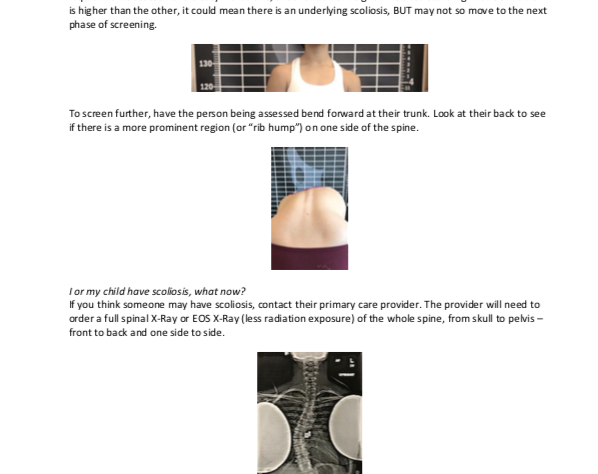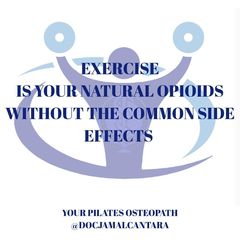When you are diagnosed with adolescent idiopathic scoliosis(AIS), many questions may come to your mind. Will I have pain with my scoliosis? Is it okay for me to exercise with scoliosis?
Not only is it okay to exercise with scoliosis, but exercise actually helps. There are many reasons why adolescents with scoliosis should make exercise a part of their program for scoliosis survivorship. As a physical therapist who specializes in scoliosis treatment, these are my top 5 reasons:
1. Exercising helps build trunk stability and strength
Although AIS is “idiopathic” – meaning we do not know exactly why it develops – we do know the effects that AIS can have on the body. The development of AIS leads to trunk asymmetries and unequal weight-bearing. These asymmetries can contribute to progression of a scoliosis curve.
Exercise, specifically types that help to stabilize the curve, can help to reduce or sometimes even reverse progression. The most effective stabilizing exercises are physiotherapy scoliosis-specific exercises (PSSE), such as Schroth, SEAS, Lyon method, and more. These are specific exercise programs that are done with physical therapists who have additional training in scoliosis, like myself. When done with bracing in growing teenagers, PSSE has shown to be effective to improve scoliosis curves.
Some research has shown that pilates and yoga offer stabilizing effects as well, especially when taught in a way that emphasizes stability over mobility – meaning holding a stable posture as opposed to only doing stretching exercises.
I find that as my patients improve in their trunk strength and stability, they report less pain! They have more muscle activation to support themselves so their overactive muscles can take a little break.
2. Exercising helps build bone density
The development of AIS often occurs at the time of peak growth. This time of peak growth also correlates with the development of peak bone mass. Usually, we reach our peak bone mass at age 30 and then it starts to slowly decrease over time. Research tells us the most important exercises to develop bone mass are weight-bearing exercises. Weight bearing exercises are performed in a standing position against gravity and include weight training, running, and jumping. These types of exercises are especially important in a growing teenager to help them develop long-term bone density, helping to prevent development of osteoporosis (where the bones become brittle) in later years.
3. Exercising is good for mental health
Exercise has the amazing ability to make you feel good! When you exercise you feel empowered that you are doing something to help your scoliosis rather than just sit, hope, and wait to see if it changes. Exercising in sports allows you the opportunity to socialize with other people who may or may not have scoliosis as well.
4. Exercising is helpful in pain reduction
To understand how exercise helps reduce pain, we have to define pain. What is pain and how do we experience it?
Pain is the brain’s analysis of a stimulus from the body. We have a highway of nerves in our body that act as an alarm system to tell us when something is wrong. Think about when you touch a hot stove, your nervous system tells your brain “OW! That’s hot” and your brain gives the signal to pull your hand away.
Sometimes, when having pain for a long time, the alarm system can become too sensitive and pain becomes more frequent. In this situation, pain signals are more easily noticed by the brain. Research tells us that exercise can help build endorphins – hormones in the brain that help to reduce the contribution of the pain signals. When we exercise, we feel better because our brain hormones help shut off some of the pain signals! Think about the pain signal as a small flame. Doing exercise builds endorphins, which is like turning on a faucet to drown out the fire of pain!
5. Sports can help you stay active!
We know from research that there are no sports that increase progression of scoliosis. This gives you the opportunity to perform whichever sport you like! Playing sports also helps with building bone density and strength as described above.
The moral of this story is that there are multiple benefits from exercising with scoliosis including pain reduction, improvements in mental health, improvements in trunk strength and stability, and improvement in the curve itself. If you want to learn exercises that can help your scoliosis, seek out a physical therapist or trainer with special training and experience in working with patients or clients with scoliosis.
Written by Beth Terranova, PT, DPT
Physical Therapist in New York, USA
Barcelona-Schroth Certified for the Treatment of Scoliosis (BSPTS-C2)
Beth Terranova, PT, DPT, is a physical therapist with an interest in treating scoliosis, kyphosis, and other spinal deformity. Her interest started with her own diagnosis of scoliosis as a teenager. She is an Orthopedic Clinical Specialist and Barcelona-SchrothCertified Therapist. She has a special interest in helping people with spinal deformity find safe and effective exercise programs to help with their pain and to promote general health. Beth competed in the sport of Olympic Weightlifting for 13+ years and continues to strength train with scoliosis. In her spare time, she loves spending time with her husband Travis and dog Marlin.


